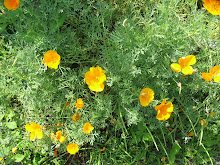This year, the garden's equivalent to the bird flu has been an innocent-looking perennial weed known as field bindweed, or by its scientific name, convolvulus arvensis. We have been advised by the Steering Committee in a recent email to "keep an eye out and dispose of it properly." Bindweed has been discovered in a few plots and will proliferate rapidly if not dealt with in a timely manner.
About a week ago, before reading the email, the skies were finally cleared from our "mini-monsoon season." I ventured over to my plot, bracing myself for what I might find around my tomatoes and peppers, which I still had not gotten around to mulching. I encountered an explosion of one type of weed in particular, so hardy it even grew under the shade of my plot-neighbor's massive squash leaves. Though I discovered that one of the compost receptacles had been quarantined because a gardener accidentally threw some bindweed in with other plant matter, I went about my usual business, filling a wheelbarrow with extraneous plant matter from my plot and dumping it in the other compost pile.
I had always thought bindweed was the vine I had growing in my own yard, which had darker and shinier petal-shaped green leaves growing straight up on a single stem. Then I read the email, and when I opened the link to the University of California Agriculture and Natural Resources site showing photos of our resident scourge, I felt a rise in my body temperature and a wave of nausea. Were the weeds I had composted the same as the bindweed seedlings shown, with its spade- or bell-shaped leaves? Had I committed germ warfare?
To be continued...


2 comments:
My first experience with a really bad insect was the Mexican bean beetle. It sounds like you had a similar sudden loss of bean plants. I learned to watch for it and pick off the larvae (the most destructive). Pyretheum also helps. This year some insect pest was even more destructive than the bean beetle. It completely destroyed my tomatillo plants--all that is left is the stem. I was never able to determine what the cause was.
But bindweed! Like you I thought it was the same as wild morning glories. I was horrified to see--after reading your post--that the flowers that had started appearing at the wilder edges of the yard are really field bindweed. So far it has not found the garden, which has enough weed pest already. Good luck.
Hi, I'm a fellow Minton Stables garner that had the same fear you did about contaminating the compost bin with bindweed. Thanks so much for posting the pigweed photo. i've got lots of that too. here's a google search of bindweed images:
http://images.google.com/images?q=convolvulus%20arvensis&ie=UTF-8&oe=utf-8&rls=org.mozilla:en-US:official&client=firefox-a&um=1&sa=N&tab=wi
Post a Comment